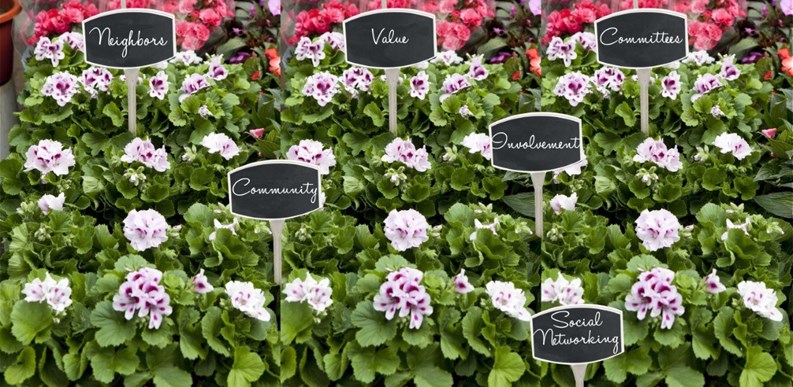The word community, like many words in the English language, has more than one interpretation. A community can be identified as a geographical location—a physical infrastructure of streets, parks and buildings, defined by tangible brick and mortar structures. But a sense of community is often emotional, intangible, and much more difficult to define; it is what makes an address a home rather than just a location—and in the context of a condo association, cultivating that sense can be of inestimable value to both residents and boards.
“There are numerous benefits of community building,” says James Gelske, a property manager with 1st Place Property Management, LLC in Coral Springs. “You have more people on the same page. More eyes looking out for fellow residents and residents will feel safer.”
Joanne M. Willoughby, PCAM, CMCA, AMS, president & CEO of Associa/Association Services of Florida agrees. “Building community builds trusts with the board and builds unity,” she says. “It allows the community to live in harmony.”
Alone Together
Cultivating a sense of community can present a challenge for residents, property managers, and association boards alike. In resort-like environments in South Florida, it is still possible to feel a disconnect from one's neighbors, even living in the same building and sharing the same amenities.
Lives are busy and schedules hectic and schedules hectic, and the last thing many people want to do when they’re at home is go socialize with the folks next door. But making the effort to build a sense of community is valuable, and creates a network of communication and support among building residents.
“It’s up to the board and managing agent, working together, to instill the feeling of community,” says Marni Berk, general manager and team leader for FirstService Residential, a property management company with properties throughout the region. “The board supplies the focus, and the agent is available for the follow-up and follow-through.”
Conversely, not proactively encouraging a sense of community can have detrimental effects on an association. “You get a real sense of disconnect,” says Gelske. “When no one is on the same page, everyone is looking out for themselves. Unfortunately when that happens, the first place a board will turn to is their property manager.”
Building Community
A sense of community doesn’t automatically appear when a new resident closes on a condo unit. There has to be a vested interest in cultivating and creating that hard-to-define but valuable support system. Chances are you will not find “foster a sense of community” in any one person’s job description. Creating that special feeling of connectivity tends to be a group effort, and requires a team approach.
One way to mobilize and connect people is by giving them a sense of ownership beyond their own four walls. Berk is in favor of using a committee approach and involving interested residents in HOA decisions whenever possible. “The board will make the final decision, but committees allow others to have a voice,” she explains. “Committees can lighten the board's workload, and having shareholders involved also helps build a sense of community and pride.”
Willoughby agrees with Berk on the importance of committees for building community relations. “There are several types of committees that the board can form,” she says. “One is an ad-hoc committee which is for one assignment only, like the budget. Once the budget is done then it’s over. There are other committees that can be ongoing for as long as the board thinks they are necessary. Two of the most important of these are social and welcoming committees. When new residents move in, you have a committee of people to show them where things are, how to do things and what’s in the neighborhood. The social committee will plan events like barbecues, holiday parties or block parties.”
“Depending on your type of population there are many things you can do to cultivate closer ties within your community,” adds Gelske. “Some communities with older populations can have a bingo night or a card night. Younger populations can have a pool party.”
In Berk’s experience, many residents have valuable skills to contribute, but she cautions, “Even with a committee, you cannot please everyone.” Also, as useful as they are, it's important to keep the scope of a committee's influence in perspective. “The purpose of a committee is to do investigative work and send their findings to the board of directors to make their decision,” says Willoughby. “So sometimes when you institute committees they think they have more power than they actually do.”
Still, she believes that personal involvement tends to make people feel good about where they live, and residents are then more likely to pick up after their pets, or check on a neighbor, and just take better care of the property in general. “Involvement helps build a different environment,” she says.
“At Associa, we hold a lot of green events and the residents love them,” says Willoughby. “Lots of people are very conscious of going green these days, so we’ll bring in a company, like Home Depot for example, who will talk about what they offer to communities or individual residents in terms of going green. Our green events are very popular and will gather residents with the same interests.”
Web-Savvy
Many managers are making use of online communications technology to strengthen communication with their client communities. Berk uses mybuilding.org, an electronic communications system that provides each property with a custom website with all its documents, updates and information, as well as info about the neighborhood—all continuously updated by the property manager and the site's support team.
Online community sites like these allow residents to log in with a private password to receive updates and to communicate with building management, or submit maintenance requests. “The internet has increased communication between boards and residents and unit owners,” says Willoughby. “I just love it.”
Berk uses this effective tool to keep residents informed on all levels, both social and maintenance. She tries to be proactive, anticipating the questions surrounding a given post, and having the answers readily available. Answers to questions like “How long will the air conditioning be serviced?” or “Where is the clothing donation bin now located?” can reassure residents and shareholders, and strengthen a sense of community by effectively saying, “we care about you.”
Berk recently sent that message loud and clear when she arranged for a fire safety event for the buildings she manages. She also promotes Project Open, as a resource for senior residents for outings and interaction. She also is aware of the who, what and where of resident-arranged and driven activities like reading groups, card and movie nights, and mahjong games. “Not every building will have space to promote and share these activities, but if a gym or community room is available, residents and management can work out some regularly scheduled events.”
“Buildings and communities are slowly catching on and need to focus more on making their websites for interactive for homeowners,” says Gelske. “Like a forum that will allow them to speak their mind so they can interact with each other. I’ve seen a lot of websites that give you basic information on the community and that’s it. Having interactive websites will certainly help build a sense of community. And for younger populations, the web is their go-to.”
Taking it Offline
Anyone looking to grow a sense of community can benefit from looking at the sensitive social interaction Berk and her team members have fostered. In one community, major holidays are recognized and celebrated in every building, all cultures are represented and the children are encouraged to make decorations and help decorate the common areas. Additionally, Berk and FirstService Residential feel board members and property managers should regularly attend social gatherings and holiday parties. “Socials provide an opportunity for interaction with residents and neighbors in an informal setting,” Berk explains. There is an opportunity we don’t normally see during regular business hours.”
Everything from yoga classes to crafts, and holiday parties can enhance a sense of community and make a property more appealing for residents and management. One of the buildings Berk manages has renamed a multipurpose room, the “play-munity room.” This adaptable space can be divided into two areas to effectively provide for events and socials. Many property managers likes to see committees involved in selecting activities and classes for community involvement. One board member will typically be in charge of a committee in order to provide seamless communication between the committee and the board.
When there is a defined sense of community and ownership residents usually take more interest in the care and maintenance of the property. If there is a loss of the sense of community, it can transfer to a lack of interest and affect the real and perceived value of a property.
Anne Childers is a freelance writer and frequent contributor to The South Florida Cooperator. Staff writer Christy Smith-Sloman contributed to this article.







Comments
Leave a Comment